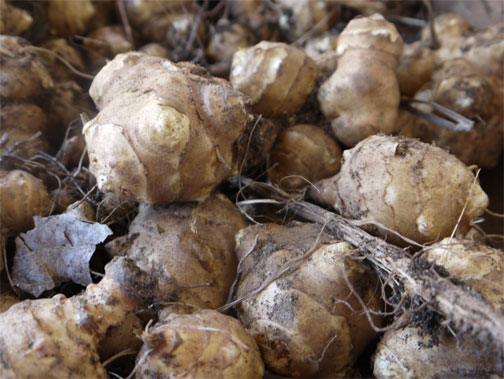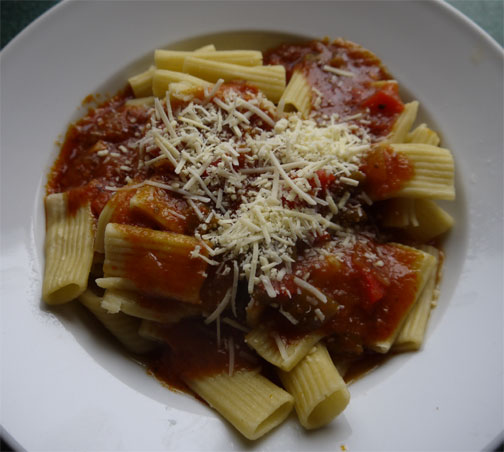Fall is coming. We feel it in our bones, we see it in the forecast, in the trees that are turning. The kids are back in school, and, of course, the tomatoes and peppers and eggplant and zucchini and green beans are piling up on the counter and overwhelming the refrigerator. What to do? Who has time?
It is harvest triage time.
I do a fair amount of preserving myself, but I am working on preserving wisdom, not volume. For example, I don’t do much with tomatoes this time of year. Most the tomatoes go into giant plastic bags, to be cooked or canned later in the fall—or winter. I cut off bad spots, but that's about all that I do at this time.
Most of the vegetables go into dinner plus. By that I mean, one jolly dinner of eggplant Parmesan, and six more aluminum foil dinners in the freezer. Or one Chinese stir-fry accompanied by soy-sesame eggplant (see July 2013), and several more containers in the freezer.
Vegetable stews are great way to preserve vegetables.
A big pot of stew makes dinner one night with garlic toasts and freshly grated Parmesan cheese. Then I freeze it in small quantities for an instant side dish or in larger quantities as a main dish. Combine the frozen and defrosted stew with broth and you have soup. Serve it over pasta and you have a different-seeming main course.
Folks I know get dispirited as they pull out bag after bag of frozen broccoli from the freezer, knowing that there is perfectly good broccoli at the store. They practically weep over all the frozen green beans still in the freezer even as asparagus season rolls around. Do something different this year. Make a yummy dinner now and freeze the rest. You won’t regret it—especially when you are extra busy. Which is always.
Oh, and all that zucchini? Some people grate it and use it in zucchini breads. But I ask you, how much zucchini bread do you want to eat? And you know that zucchini pickles are never as good as cucumber pickles.
Forget about it. Zucchini is a seasonal treat; it’s green and fresh and tastes like summer. Treat it like the summer vegetable it is and do not preserve it except in stews and the pasta dish below.
You’re welcome.

Big-Crowd Vegetarian Pasta Casserole
Makes 12 to 16 servings
I developed this recipe for my book, Mom’s Best Crowd-Pleasers, which came out in 2006. I use the recipe as a guide—meaning I don’t necessarily use the mushrooms and the canned artichokes (though both do add to the recipe). And instead of the bottled spaghetti sauce and canned tomatoes, I make a batch of sauce; you’ll need about 2 quarts of sauce and another quart of fresh chopped tomatoes or 3 quarts of sauce. Add plenty of fresh basil, oregano, and thyme.
2 pounds small shells or other small pasta shapes
3 tablespoons extra virgin olive oil
1 onion, diced
2 green bell peppers, diced
2 red bell peppers, diced
2 medium zucchini, quartered and sliced
4 garlic cloves, minced
1 pound mushrooms, trimmed and sliced
1 (14-ounce) can artichoke hearts (about 6 artichoke hearts), rinsed, drained, and quartered
2 (26-ounce) bottles spaghetti sauce
1 (28-ounce) can diced tomatoes with juice
Salt and freshly ground pepper
1 pound mozzarella cheese, grated
2 cups freshly grated Parmesan cheese
1. Cook the pasta in at least 10 quarts of boiling salted water until just done. Drain well. Transfer to a large mixing bowl.
2. Preheat the oven to 350°F.
3. Heat 2 tablespoons of the oil in a large skillet over medium-high heat. Add the onion, bell peppers, zucchini, and garlic and sauté until the vegetables are limp, about 6 minutes. Use a slotted spoon to transfer the vegetables to the bowl with the pasta.
4. Return the skillet to medium-high heat. Add another 1 tablespoon of oil to the skillet. Add the mushrooms and sauté until well browned, about 8 minutes. Scrape the mushrooms and their juices into the bowl with the pasta and vegetables. Add the artichokes.
5. Add the spaghetti sauce and tomatoes to the pasta and mix well. Season to taste with salt and pepper. Mix in half the mozzarella and half the Parmesan cheeses. Transfer the mixture to a large roasting pan—or to 3 or 4 ceramic or aluminum baking dishes. Sprinkle the remaining cheeses on top.
6. Bake for 45 minutes when freshly made and in casserole to serve 4, or for 1 hour to serve a big crowd. When serving the frozen casserole, defrost overnight and bake for 1 hour or bake for 1 1/2 hours straight out of the freezer. Keep covered for the first hour.
Recipe adapted from Mom’s Best Crowd-Pleasers by Andrea Chesman. ©2006. All rights reserved.



































































